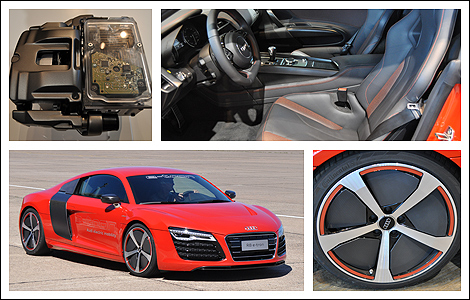A legend that never got its time
Audi does not do things half-assed. When they put their collective genius and substantial resources behind an idea or project, they go all the way.
The Audi R8 e-tron is perhaps the greatest effort and finished product that will never see the light of day. Although sad -- and in a way, a waste -- the lessons learned by Audi on this specific and spectacular project will live on in many upcoming Tron cars.
The 2013 Audi R8 e-tron is a contradiction on four wheels where efficiency and mind-blowing performance meet in an incredibly sophisticated package. There would have been no better way to be green, fast, and look devilishly good all at once.
What is an Audi R8 e-tron?
The 2013 Audi R8 e-tron is the fully electric iteration of Audi's supercar and was to be a flagship Tron model. However, Audi decided that the feasibility of such a car on the current market was limited.
Truly, Audi invested large amounts of money and resources into this phenomenal car, and the potential retail price would have reportedly fetched over $1 million. The
Mercedes-Benz SLS AMG E-Cell is slated to retail for just over $500,000. Despite the R8 e-tron being an exceptional automobile and a technical tour de force, Audi cancelled production plans.
Therefore, the R8 e-tron is the test bed for countless innovations from carbon-fiber-reinforced polymer (CFRP) layering to a multi-source heat pump to brake-by-wire rear calipers.
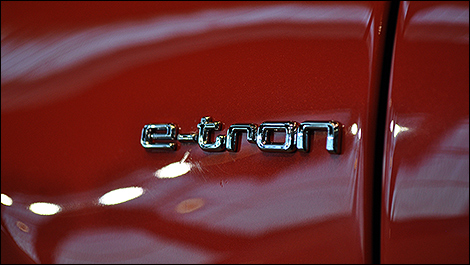 |
| The 2013 Audi R8 e-tron is the fully electric iteration of Audi's supercar and was to be a flagship Tron model. (Photo: Mathieu St-Pierre) |
Technicalities
Forward moment in the 2013 Audi R8 e-tron is indirectly handled by 530 lithium-ion cells supplied by Panasonic. Together, they generate 48.6 kWh of power. The battery containing the cells is all Audi, and they feed the twin rear-mounted 140 kW electric motors. The combined 280 kW equates to a 380 hp output.
As with any electric car, torque makes the world of difference: the e-tron's 820 Nm (605 lb-ft) of twisting power is sufficient to launch it to 100 km/h in 4.2 seconds. Top speed is electronically limited to 200 km/h - ungoverned: could reach 250 km/h. With a full charge, the R8 e-tron has an operating range of 215 km.
The Audi R8 e-tron is built on an aluminum ASF (Audi Space Frame) blended with large portions made of carbon-fiber-reinforced polymer (CFRP). The car's total unladen weight is 1,780 kg (3,924.23 lbs). By comparison, an automatic R8 V10 tips the scale at 1,720 kg.
A full charge through a 220-Volt socket requires roughly 12 to 14 hours.
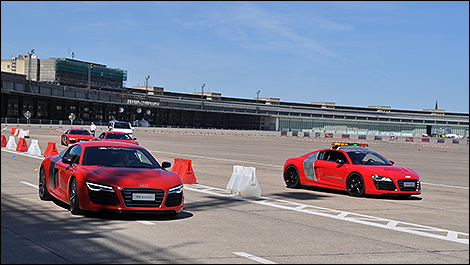 |
| The e-tron's 820 Nm (605 lb-ft) of twisting power is sufficient to launch it to 100 km/h in 4.2 seconds. Top speed is electronically limited to 200 km/h - ungoverned: could reach 250 km/h. (Photo: Mathieu St-Pierre) |
Driving the Audi R8 e-tron
The R8 e-tron adventure does not begin immediately. Starting the beast and sliding the lever into “D” is no more special than doing it in a Toyota Prius Plug-In. Its shape and a distinct, enticing hum or synthetic e-sound emitted by the R8 e-tron upon start-up are the only signs that this vehicle is something different.
Audi's Drive Select is the car's nerve command centre. When left alone in default mode, the R8 e-tron is as docile as a Nissan LEAF, despite the fact that it will shred pavement at the drop of the go pedal. In Dynamic and with ESP in Sport, this EV suffers no performance anxiety.
My first time at the starting line, I did what any warm-blooded human would do: I tried to push the throttle through the firewall. In a half instant, the back of my head was buried in the headrest and I was sporting a stupid grin.
As far as challenging apexes, the R8 e-tron is limited slightly in lateral grip by its 19” optimized rolling-resistance tires. As both electric engines can theoretically operate separately, this enables torque vectoring: a fancy way to say that the outside wheel can accelerate and literally push the car into a corner. It works impressively well.
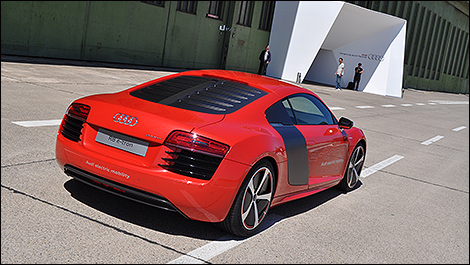 |
| When left alone in default mode, the R8 e-tron is as docile as a Nissan LEAF, despite the fact that it will shred pavement at the drop of the go pedal. (Photo: Mathieu St-Pierre) |
Inside and out of the Audi R8 e-tron
The regular Audi R8 is composed of roughly 6,000 components. Of them, the e-tron only shares nine. To put it in perspective: The two cars only share similar doors.
From afar, there are a few distinctive differences: The rear CFRB louver replaces the glass; on it is mounted the camera for the virtual interior mirror that features active matrix organic light emitting diodes (AMOLED). The trick wheels have adjustable flaps that close at 50 km/h (31.07 mph) to slightly improve aerodynamics.
The cabin's design is lifted from the “common” R8; however, is lathered in CFRP, Alcantara, and leather. My favourite item: the CFRP fixed-back sport bucket seats.
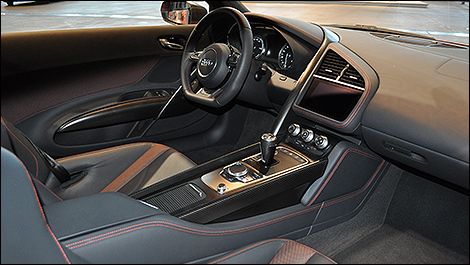 |
| The cabin's design is lifted from the “common” R8; however, is lathered in CFRP, Alcantara, and leather. (Photo: Mathieu St-Pierre) |
Comparing the Audi R8 e-tron
Although the Audi R8 e-tron will not make it to dealerships, it would have competed with some equally spectacular EVs. The Mercedes-Benz SLS AMG E-Cell and
BMW i8 would have been the R8's only real competition.
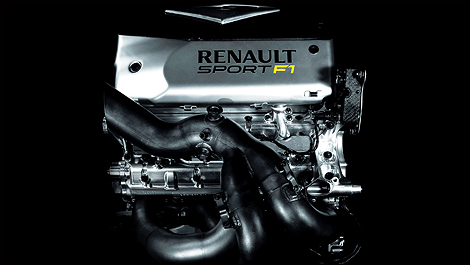
 The latest auto news, reviews, prices, product and vehicle releases.
The latest auto news, reviews, prices, product and vehicle releases. 